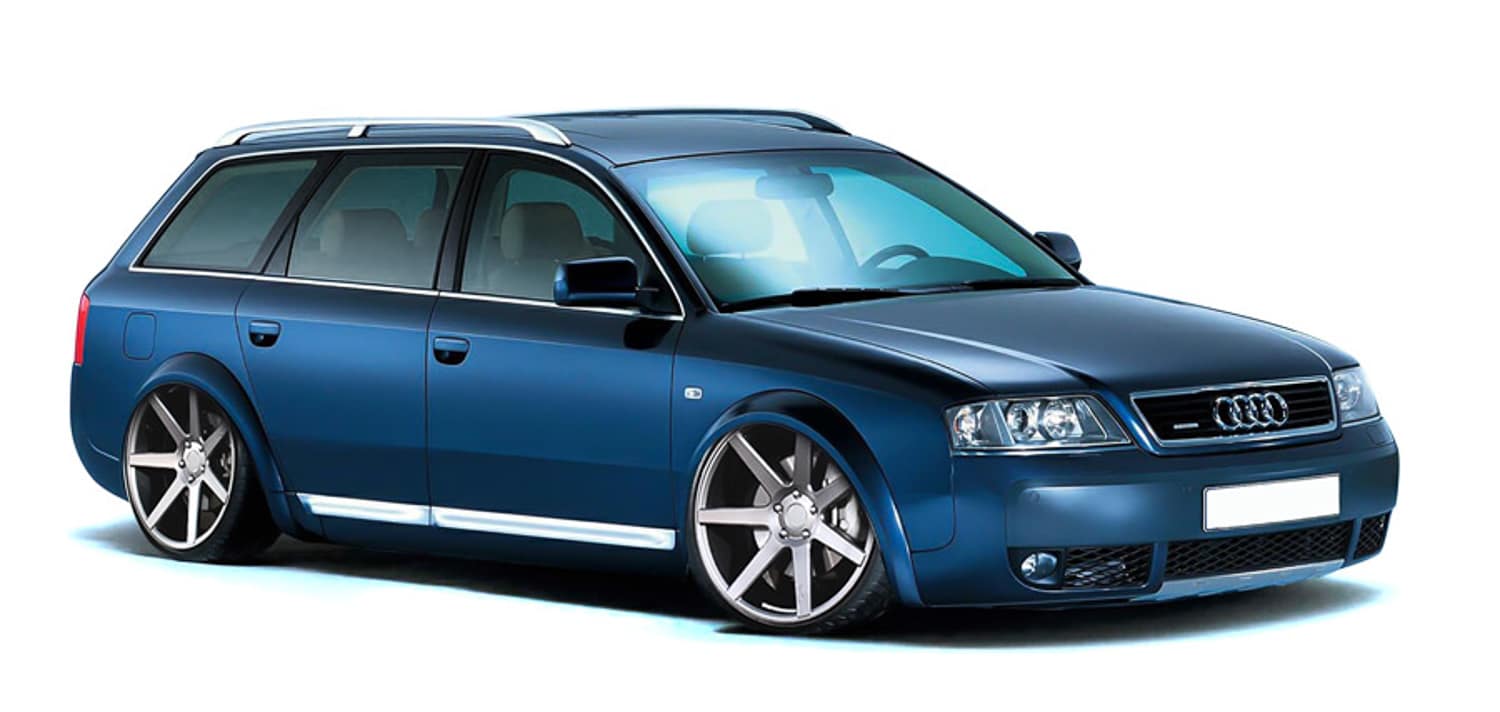We all love a good sleeper, whether it’s a factory-appearing performance car, or one that your nana would drive — but with oodles of power, they’re all just as effective at getting the job done. We set out to find the most affordable sleepers that’ll see you pull away from your mates with ease, or leave the unsuspecting citizen in complete dismay. So, here are five cars that you can pick up for less than $5000.
Nissan R’Nessa GT, 1997–2001, $3000–$5000

The R’nessa has to be number one on our list thanks to its extremely potent SR20DET engine, which is commonly found in Nissan GTI-R Pulsars, Silvias, and Avenirs. Although not as potent as the GTI-R’s SR20DET powerplant, and a different configuration to the Silvia’s motor, it has just as much potential. The NN30 R’nessa produces a very solid 147kW (197hp) and 265Nm of torque which, combined with the factory all-wheel-drive system, has no problem getting the power to the ground. Top speed is fairly impressive too, considering it weighs in at 1640kg — leave it stock and it’ll do 220kph (with the speed limiter removed, of course). You’ve got a couple of options to make it produce more power, but it all depends on what you want your boost response to be like. Replacing the small factory Garrett T25 with a larger T28 from a GTI-R and manifold can net some very good top-end gains, however boost response down low will suffer, which in an automatic can be terrible. The second-best option is to install the Avenir GT4-Z factory turbo, as it’s a ball-bearing T25, so boost response is much better and it’ll make a little bit more power. However, you just can’t go past the GT2860R as found in the Nissan Silvia S15. They’re a T28-frame turbo like the GTI-R turbo, but with the added benefit of being a ball-bearing set-up. Have fun modifying the SR20DET, as there is plenty of torque to be had, just make sure you install an auto trans cooler to prolong the life of the automatic.
Audi Allroad 2.7T (C5), 1999–2005, $5000

Audi has been building bonkers turbocharged cars since the ’80s. This turbocharged technology has slowly trickled down to its family sedans and estate wagons over the past two decades, and so for under $5000 you can purchase a fairly late-model Audi Allroad (C5). The Allroad features a 2700cc twin-turbo V6 engine that produces 180kW (241hp) and 330Nm of torque. The Biturbo engine, as it’s known, was also featured in the B5-platform S4 and responds extremely well to modification.
A simple reflash will see a 37–45kW (50–60hp) gain in power, or for more the factory twin K03 turbochargers can easily be replaced with K04s. Companies overseas, such as 034Motorsport, stock huge amounts of upgrades for this engine — providing an almost limitless combination of turbos, cams and internals. Although heavy in factory trim — it weighs in at 1825kg — the Allroad is an excellent open-road tourer with cloud-like suspension that is height adjustable thanks to an electronically controlled air-ride suspension set-up — drop it down for the curves, or raise it up for the kerbs. Quattro all-wheel drive is standard with the 2.7T, so no matter how much power you decide to squeeze out of the V6, traction won’t be an issue, however, regular transmission servicing is recommended. The interior has the luxuries you’d expect from Audi, such as a Bose sound system, a leather interior with heated front seats, and dual-climate air conditioning. Modify the air-ride suspension, slam it down, and make use of those extremely wide factory-flared guards with a big set of wheels.
Mitsubishi RVR Hyper Sports Gear R, 1991–1997, $3000–$5000

The Evo for families on the go, the RVR has the ability to solve everyone’s problems, given its SUV-like appearance, and a lethal 4G63T engine under the hood that’s easily modified for much larger power figures. In factory form the RVR weighs in around 1380–1545kg depending on trim, which makes it much lighter than the R’nessa.
The biggest thing the RVR has going for it is that 4G63T engine, which in a slightly watered-down form (compared with an Evo) produces 170–184kW (227–247hp) and propels the SUV to 100kph in 6.8 seconds, on its way to a top speed of 217kph. More impressively, the factory quarter-mile time is 14.9 seconds, thanks to its all-wheel-drive five-speed-manual gearbox. If that’s not fast enough for you and you need to get the kids to school quicker, pulling off the factory TD04-15T and replacing it with a TD05H-16G as found on Evo I-IIIs is by far the most affordable option. And while you’re raiding the Evo parts bin, track down a factory Evo front-mounted intercooler, as they’re good quality and not overly large, so boost response should remain near-on factory. The factory boost cut on the RVR is said to be around 15–17psi, so don’t get near these boost levels as you’re likely to max out the factory 450cc injectors.
With an Evo turbo, some sort of engine management, a boost increase and some skills, your RVR should run mid 13s down the quarter with ease. There aren’t many soccer vans that can claim that kind of performance.
Rover 220 coupé ‘Tomcat’, 1992–1998, $2000–$3000

The Rover that Honda should have produced, the Rover 220 GTI or ‘Tomcat’— as it’s known among enthusiast circles — is an extremely fast and affordable sleeper. Rover, commonly a brand owned by elderly people, produced the 220 coupé from 1992–1998, a model based off the Honda Concerto platform. Step inside the cabin and it’s instantly evident that Rover used every part it could from the Honda parts bin to guarantee longevity, but it decided to add its own woodgrain trim to fancy things up a bit.
You don’t buy a sleeper for the interior though, so here’s the goods. With a kerb weight of only 1185kg the Rover was an absolute rocket ship, and could hit 100kph from a standing start in 6.2 seconds and charge on to a top speed of 241kph — a speed that would put most 2015 vehicles to shame. What made it so fast? Did Rover pinch VTEC from Honda too? No — the turbocharged 2000cc four cylinder made use of a Garrett T25 turbo and Torsen differential. In factory trim, it produced 147kW (197hp) and 236Nm of torque on 7psi of boost. Modifications are virtually the same as the R’Nessa we mentioned earlier — a T28 is a great bolt-on turbo option, accompanied by a high-flow exhaust, high-flow air filter, and front-mount intercooler. Unfortunately, Rover skimped on the pistons in the 220 coupé, so make sure boost doesn’t go over 12psi. If you are looking for one, try get one that has had the head gasket changed, as they’re known to leak oil, however, it doesn’t affect performance (it does require the head to be removed for repair).
Volvo S80, 1998–2006, $2000–$4000

If you’re looking for a large sedan, with leather interior and a twin-turbo straight six, then the Volvo S80 is for you. The first-generation S80 was produced for a wide variety of markets, so came with 12 different engine combinations — whether you were after an economical diesel engine, or a turbocharged large-capacity petrol engine, Volvo had you covered. Weighing in at 1605–1712kg, the Volvo was no lightweight in factory form thanks to an extensive list of luxuries and safety features (the 2001 model came with a fax machine as an option), however, it did feature a 2922cc twin-turbo straight six that produced 200kW (268hp). We had a scrounge around the Volvo tuning forums (yeah that’s right, they exist), and from what most people are saying, you can modify them as you would any turbocharged car. A bigger exhaust system, intake, and an ECU reflash will see power go from 200kW to around 246kW, but anything over this and the transmission won’t handle it. The Volvo came with both an automatic transmission and a manual gearbox, but they’re both front-wheel drive, so torque steer was an issue. This is, however, the safest and most powerful factory sleeper you can purchase for well under $5000.
This article was originally published in NZ Performance Car Issue No. 225. You can pick up a print copy or a digital copy of the magazine below:






